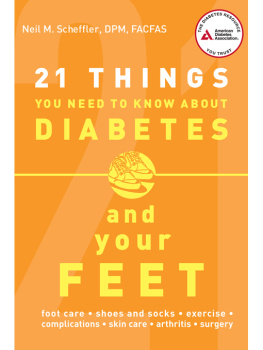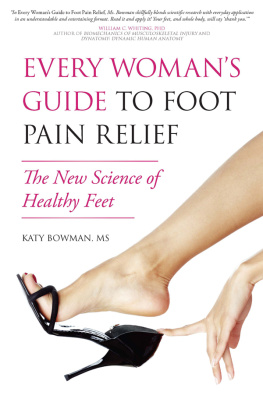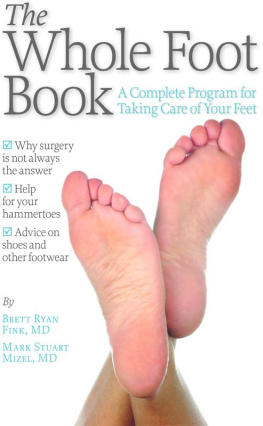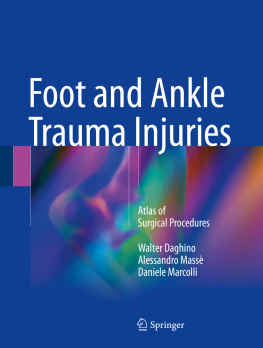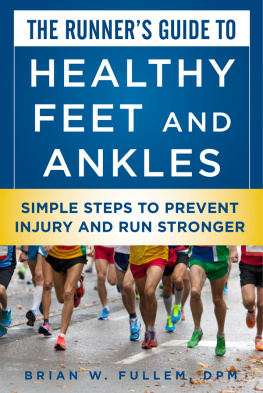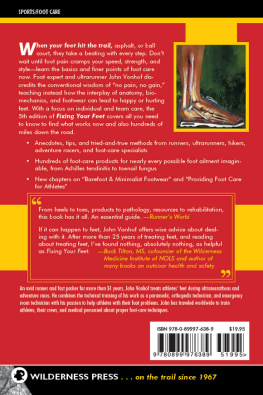thefoot
book
A Johns Hopkins Press Health Book
the foot
book
A Complete Guide to Healthy Feet
Jonathan D. Rose, D.P.M.
and Vincent J. Martorana, D.P.M.

Note to the Reader. This book is not meant to substitute for medical care, and treatment should not be based solely on its contents. Instead, treatment must be developed in a dialogue between the individual and his or her physician. Our book has been written to help with that dialogue. At-risk patients, such as people with diabetes or peripheral vascular disease, should never engage in the self-care remedies that are described in this book.
The authors acknowledge the assistance of Bruce Beacham, M.D., F.A.C.P., F.A.A.D., who helpfully reviewed for them.
2011 The Johns Hopkins University Press
All rights reserved.
Published 2011 Printed in the United States of America on acid-free paper
9 8 7 6 5 4 3 2 1
The Johns Hopkins University Press
2715 North Charles Street
Baltimore, Maryland 21218-4363
www.press.jhu.edu
Library of Congress Cataloging-in-Publication Data
Rose, Jonathan D.
The foot book : a complete guide to healthy feet / Jonathan D. Rose and Vincent J. Martorana.
p. cm.
Includes index.
ISBN-13: 978-1-4214-0129-4 (hardcover : alk. paper)
ISBN-13: 978-1-4214-0130-0 (pbk. : alk. paper)
ISBN-10: 1-4214-0129-0 (hardcover : alk. paper)
ISBN-10: 1-4214-0130-4 (pbk. : alk. paper)
1. FootCare and hygiene. I. Martorana, Vincent J. II. Title.
RD563.R587 2011
617.585dc22 2010049757
A catalog record for this book is available from the British Library.
Special discounts are available for bulk purchases of this book. For more information, please contact Special Sales at 410-516-6936 or specialsales@press.jhu.edu.
The Johns Hopkins University Press uses environmentally friendly book materials, including recycled text paper that is composed of at least 30 percent post-consumer waste, whenever possible.
Preface
MOST PEOPLE ARE PROBABLY more familiar with the structure of the hand than of the foot, because we do so much with our hands every day. Yet, the foot is equally valuable and remarkable in what it allows us to do. The foot, ankle, and lower leg are designed to support us and make it possible for us to move. For these reasons, the foot is bulkier than the hand, which is designed to make fine, skilled, and articulate movements.
The bones and joints of the foot are larger and wider and the muscles stronger than their counterparts in the hand. Unlike the fingers, the four small toes cant move individually. The big toe has a separate set of muscles, but even so, this toe doesnt have the range of movement that a thumb has. But thats okay, because most of us dont expect to play the piano with our toes. We do expect our feet to support our weight and enable us to walk, run, dance, play sports, and so on, day in and day out for a lifetime. And we expect our feet to do all this without causing us pain or discomfort. Given that the average person may take 4,000 steps in a day1.5 million steps in a yearand that many people take far more steps than that, we expect an awful lot of our feet.
The feet are often referred to as a mirror to the body. If you think of the bodys blood vessels and nerves as branches extending from the heart and the brain, then the feet are at the very tips of the branches. If the blood vessels cant carry enough blood or if the nerves cant conduct a strong enough signal, the problem will likely be noticed first at the tips of the branches. The feet, therefore, often indicate the state or condition of the rest of the body. They can be a reference to a possible body-wide (systemic) disease. So it makes sense to pay attention to the feet.
As podiatristsfoot and ankle specialistswe pay attention to other peoples feet every day. We have combined our years of experience to write this book about the most common reasons people go to a podiatrist. We hope that in reading the bookor the sections relevant to youyou will gain a better appreciation of your feet and helpful information about the possible causes and available treatments for whatever ails them. This book does not cover every single foot and ankle condition, but we have included all those that we regularly see in our practices. We dont mean for the book to replace your physician, nor for it to be a treatment guide in place of consulting a podiatrist. Rather, we intend for readers to use it to gather information before going to a podiatrist or to learn more after receiving a diagnosis. Thus, this book is for people who have or think they may have a foot or ankle problem, as well as for family members of patients and for parents who are concerned about possible problems in their childs feet or way of walking.
This book is in three parts. introduces the development and structure of the foot, various terms used to describe foot positions and movements, and the mechanisms behind how we walk. We discuss basic personal foot care and the podiatry profession in terms of whom you might see for a foot or ankle problem, how to prepare for an appointment, and what types of examinations and tests you can expect. We also provide an overview of shoes and how to choose properly fitting footwear.
consists of nine chapters, each of which discusses foot disorders related to a different part of the foot, such as the toes, toenails, or heel, or to a particular structure within the foot, such as the nerves, joints, or tendons. Every chapter describes various disorders and conditions, and for each we explain the causes, symptoms, diagnosis, and treatment options.
focuses on people with special foot needs, including children, sports enthusiasts, and people with diabetes. The final chapter discusses orthotics, which include custom-molded arch supports, braces, and other devices commonly used to help support and realign feet. At the end of the book is a resources section listing associations and websites that provide additional reliable information.
With the exception of the figure on , the illustrations that appear in the book were drawn by Dr. Martorana and the photographs are from Dr. Martoranas personal collection. Greg Nicholl at the Johns Hopkins University Press assisted with the final preparation of the illustrations.
We hope that this book is helpful as one of the steps you take in learning more about your remarkable feet.
Part One
Introduction
Chapter 1
A Guide to the Foot and How We Walk
MOST OF US DONT remember a time when we couldnt walk. As infants, we progressed from lying to sitting, crawling to standing, and then to walkingor for some babies, runninglong before our first memories took root. When babies take their first staggering steps, they begin their practice of a complex task that involves balance and coordination, muscles and joints, legs and feet. The process of walking is a basic, everyday activity for many people, and, with the obvious exception of those who have mobility difficulties, most people take their ability to walk entirely for granted. They also take for granted the remarkable part of the human body that bears the brunt of a walkers weight and contributes so much to walking: the foot.
As with many aspects of our health, people dont usually think much about their feet until a foot disorder or foot injury causes them pain or difficulty walking. Foot health is extremely valuable to overall body health, and the feet have much to tell as indicators of potential health problems. We would all do well to put up our feet and learn about keeping them healthy.
Next page


